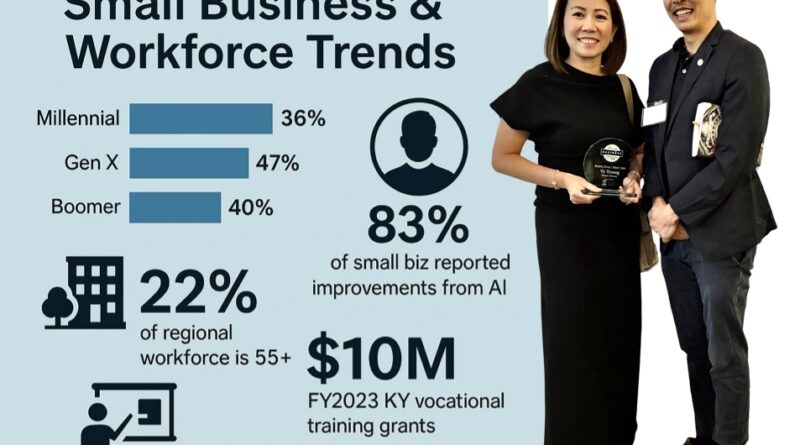Leadership Profile: Di Tran – Next-Generation Entrepreneur and Educator in Louisville – RESEARCH JUNE 2025
Di Tran is a Vietnamese-American business leader, educator, and AI advocate building the future of Louisville’s economy. As a millennial entrepreneur, he exemplifies the new wave of leadership bridging traditional industries and cutting-edge technology. His work in vocational training (e.g. Louisville Beauty Academy and Di Tran University), real estate development, and AI underscores the broader demographic and economic trends transforming Louisville and the U.S.
Generational Shifts: Millennials and Gen X Rising, Boomers Retiring
National and local data confirm that younger generations are assuming ever-greater roles in business. For example, U.S. labor‐force composition shifted dramatically in 2023–2024: Millennials now comprise 36% of the workforce, far outpacing Baby Boomers (15%). Likewise, small-business ownership is concentrated among Gen Xers and Boomers: roughly 47.2% of small-business owners are Gen X and 39.6% are Boomers, while Millennials account for only ~13%. In Louisville, Millennials are already the largest age group in the population, reflecting this generational turnover. As an energetic Millennial leader, Di Tran personifies this shift. He brings a digital-first mindset where many long-established businesses still rely on aging leadership. His example signals how next-gen leaders are stepping up as Baby Boomer owners retire and ownership passes to younger hands.
- Millennials now form the largest share of American workers (36% in 2024) versus only 15% for Baby Boomers.
- Gen Xers (born 1965–1980) make up 47.20% of U.S. small-business owners, Boomers 39.63%, and Millennials only 12.92%.
- Louisville’s workforce and population have a growing Millennial cohort (~28% regionally), highlighting a young talent pool.
Business Succession & Digital Readiness Gaps
Aging ownership poses challenges in Louisville and nationwide. Roughly 40% of U.S. small-business owners are Baby Boomers, with millions reaching retirement each year. Yet less than one-third have a formal exit or succession plan. This “silver tsunami” of retiring entrepreneurs threatens to leave community businesses orphaned or sold off. Compounding the issue, many long-time owners lack digital savvy. Studies show a pronounced generational digital divide: for instance, although 80% of Americans over 65 have internet access, only 61% have basic digital skills (e.g. connecting to Wi-Fi, using apps). The result is a gap in “digital readiness” that can stall business growth or sale. Di Tran’s tech-forward leadership and emphasis on training help bridge this gap. By promoting AI and modern tools in his businesses, he prepares Louisville’s workforce for the future while helping older businesses modernize or transition.
- Succession crisis: 40% of U.S. small-business owners are Boomers, but fewer than 30% have a planned exit.
- Aging workforce: In Louisville/KIPDA, 22% of the regional labor force is age 55+ (and 24% in manufacturing), intensifying retirement turnover.
- Digital skills gap: 80% of over-65s have internet but only 61% possess essential digital skills, highlighting the need for youth-led tech training.
AI Literacy and Small Businesses
Artificial intelligence is rapidly reshaping business, and small companies seek AI-competent leadership. A 2023 poll of U.S. small-business owners found 83% of those using AI reported improvements (greater efficiency, better content creation), and 58% plan to invest in AI in the next year. Crucially, younger owners are much more comfortable with AI: 79% of owners under 35 view AI positively compared to only 53% of owners 65 or older. This gap mirrors the broader generational tech divide. Barriers remain high – 55% cite the cost of AI tools, and 46% cite employees’ lack of digital skills as obstacles. Di Tran’s advocacy for AI education (through his institutes and writing) meets this need head-on. He embodies the kind of AI-literate leadership that businesses increasingly require. Industry analysts note that modern leaders need “baseline fluency” in AI to guide teams – understanding how to ask the right questions and integrate AI ethically. Di’s public speaking and AI-powered education initiatives position him as a guide for Louisville companies navigating this transformation.
- AI adoption surging: 54% of AI-using small businesses saw positive growth impacts; 33% are early tech adopters and 58% plan near-term AI investments.
- Youth lead AI comfort: 79% of owners <35 report AI helped their business vs. 53% of owners 65+.
- Barriers: High tool costs (55%) and digital skill shortages (46%) are the top hurdles for small businesses to adopt AI.
- Leadership shift: Experts argue 2025 leaders must be “AI-literate guides,” not just technology experts.
Vocational Training and Workforce Development
Regional strategies in Louisville and Kentucky emphasize vocational education as key to economic growth – areas where Di is active. Greater Louisville Inc. (the regional development group) sets a goal for Louisville to have “the most competitive workforce on the globe,” by developing a world-class education system and workforce training. Statewide, Kentucky has poured resources into skills training: for example, the Kentucky Cabinet approved over \$10 million in grants to train nearly 35,000 workers in FY2023, and similar multi-million-dollar programs reached over 30,000 trainees in FY2024. These programs cover industry-specific training at companies (e.g. Ford Louisville) and help hundreds of local employees upgrade their skills. The urgency is clear: the workforce is aging, and many skilled positions will open. In the Louisville region, nearly one in three machinists/mechanics is 55 or older. Institutions like Di Tran’s vocational schools directly feed this need. For example, Louisville Beauty Academy (LBA) provides licensed vocational training (nail tech, cosmetology, etc.) to thousands – many of them immigrants or first-generation Americans – creating a pipeline of certified professionals. By aligning curriculum with regional labor needs (and even offering AI-enhanced learning through “Di Tran University”), Di’s work helps reverse the post-pandemic dip in career-tech graduates.
- Training investments: Kentucky’s Bluegrass State Skills Corp. funded training for ~35,400 workers in 2022 and 42,600+ in 2024.
- Workforce aging: In KIPDA (Louisville area), 22% of workers are age 55+; in manufacturing it’s 24%, creating high replacement demand.
- Regional priorities: GLI explicitly targets “homegrown workforce” via education and training programs, goals mirrored by Di’s educational initiatives.
- Immigrant workforce: Programs at LBA and Di’s enterprises help immigrants and minorities gain licensed careers, turning local populations into skilled workers.
Immigrant and Minority Entrepreneur Contributions
Di Tran’s personal background as a Vietnamese immigrant entrepreneur reflects broader research on how new Americans energize mid-sized city economies. National studies show immigrants are disproportionately entrepreneurial. For instance, immigrants are only ~13% of the U.S. population and 16% of the labor force, yet they own 28% of “main street” small businesses (retail, food services, neighborhood services). These locally embedded businesses drive neighborhood revitalization: immigrants “have transformed deteriorating and abandoned street fronts into vibrant urban environments”. In Louisville, foreign-born residents are far more likely to be self-employed than native-born: one study estimated immigrants are 22 times more likely to be entrepreneurs in Louisville (reflecting patterns in many mid-sized cities). Di’s own ventures exemplify this impact. His Louisville Beauty Academy provides career paths for immigrant and minority students, many of whom lack prior formal credentials. By legitimizing and training these entrepreneurs, he turns community members into contributors. His story is highlighted in local media as a “beacon of hope” for immigrant communities.
- High immigrant entrepreneurship: Immigrants, 13% of U.S. pop, comprise 28% of “main street” business owners, fueling local economies.
- Neighborhood revitalization: Immigrant businesses disproportionately revive underused urban areas.
- Diversity in small biz: Asian-owned businesses number ~581,200 nationwide, controlling ~24% of restaurants/hospitality sectors; Hispanic-owned businesses number ~346,800.
- Local impact: In Louisville, Di’s LBA gives hundreds of immigrants their first legal career licenses, illustrating how minority-led training programs build community wealth.
Affordable Housing and Mixed-Use Development
Inclusive economic growth also depends on stable, affordable housing and smart community planning. Nationwide, the U.S. faces an 8–9.6 million unit housing shortfall by 2035, largely affecting lower-income and minority families. Addressing that gap has enormous returns: closing it could add nearly \$2 trillion to GDP and create almost 2 million jobs over a decade, largely through construction and supply chains. Local governments increasingly treat housing policy as economic development. Experts note that mixed-income, mixed-use developments bring broad benefits. For example, ensuring affordable housing allows businesses to attract a stable, local workforce (reducing long commutes) and boosts retail sales, since residents have more disposable income. Such projects also “raise the value of the property and the tax base,” enabling reinvestment. Di Tran has applied these ideas in his real-estate projects (e.g. integrated housing-and-health models with NABA Foundation). His focus on “beautify with purpose” and compact affordable housing reflects the trend: mixed-use developments are seen as engines of inclusive growth, linking commerce, homes, and community services.
- Economic impact of housing: Eliminating the housing shortfall could boost GDP by ~\$2 trillion and add ~2 million jobs.
- Workforce stability: Affordable, local housing helps businesses retain employees; without it, workers face long commutes or high rent burdens.
- Mixed-income perks: Developments with affordable units improve neighborhood diversity and amenities for all residents.
- Community investment: Building mixed-use projects on underutilized land increases property values and tax revenues, funding further local projects.
Conclusion
Di Tran’s profile – as a young, minority, tech-savvy entrepreneur and educator – is deeply connected to these trends. He is a Millennial leader stepping into roles that national data show are increasingly dominated by younger generations. He addresses the “silver tsunami” and digital divide by infusing AI and online education into traditional fields. His companies train workers and immigrants, aligning with Louisville’s workforce-development goals. And his community-driven projects in housing and urban revitalization echo the inclusive growth strategies experts recommend. In all, the research-backed trends around generational change, AI adoption, vocational training, immigrant entrepreneurship, and mixed-use development not only contextualize Louisville’s economy – they also underscore why Di Tran’s leadership and vision are both timely and transformative.
Key Statistics: Millennials now comprise 36% of the U.S. workforce; 40% of small-business owners are Baby Boomers (many retiring); 83% of AI-using small businesses report productivity gains; Kentucky trained ~35,000 workers in FY2023 via state programs; immigrants (13% pop) own 28% of U.S. “main street” businesses; closing the housing gap could add ~\$2 trillion to GDP.
References
- U.S. Small Business Administration. (2023). Baby Boomers and Business Succession: Planning for the Future of America’s Small Businesses. SBA Office of Advocacy. https://advocacy.sba.gov
- Pew Research Center. (2021). Older Adults and Technology Use: Digital Readiness and Literacy Among Americans 65+. https://www.pewresearch.org
- U.S. Chamber of Commerce. (2023). Artificial Intelligence and Small Business Survey: AI Adoption and Trends Among U.S. Small Business Owners. https://www.uschamber.com
- SCORE Association. (2023). Small Business AI Readiness Survey: Generational Differences in AI Adoption. https://www.score.org
- Harvard Business Review. (2024). What Every Leader Needs to Know About AI: Becoming an AI-Literate Manager. https://hbr.org
- Kentuckiana Regional Planning and Development Agency (KIPDA). (2023). Workforce Trends and Aging in Greater Louisville: Labor Market Analysis Report. https://www.kipda.org
- Greater Louisville Inc. (2023). Greater Louisville 2030 Regional Economic Growth Strategy. https://greaterlouisville.com
- Fiscal Policy Institute & Americas Society/Council of the Americas. (2022). Bringing Vitality to Main Street: How Immigrant Small Businesses Help Local Economies Grow. https://fiscalpolicy.org
- Center for an Urban Future. (2023). Immigrant Entrepreneurs Revitalizing Main Street: Transforming Commercial Corridors in American Cities. https://nycfuture.org
- National Association of Realtors. (2023). Housing is Critical Infrastructure: Economic Benefits of Closing America’s Housing Supply Gap. https://www.nar.realtor
- Urban Land Institute. (2022). Mixed-Income, Mixed-Use Development: A Toolkit for Inclusive Economic Growth. https://uli.org
- U.S. Bureau of Labor Statistics. (2024). Labor Force Statistics from the Current Population Survey: Workforce Composition by Age, 2024. https://bls.gov
- Guidant Financial & Small Business Trends Alliance. (2024). Small Business Trends and Demographics Report 2024. https://www.guidantfinancial.com
- Kentucky Cabinet for Economic Development. (2024). Annual Report on Workforce Development and Bluegrass State Skills Corporation Training Programs. https://ced.ky.gov
- Louisville Public Media. (2024). Profiles in Community Leadership: Di Tran and Vocational Education’s Role in Louisville’s Economic Growth. https://lpm.org




